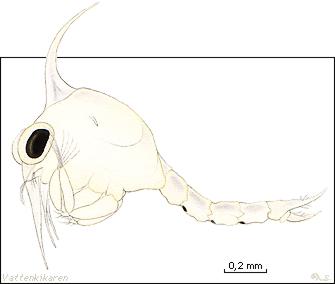 |
 |

 Distribution in scandinavian waters |
Maximum length: It is difficult finding
information about the maximum size. Compare
with the size of a hair. Appearance: Crab zoea larvae have a strong and almost spherical carapace to which the legs it uses for swimming are attached. Legs are absent on the long and extended back. The often long and prominent rostrum always points downwards, but can on occasion also be absent. Crab zoea larvae usually have several other outgrowths on their body, amongst them a very prominent vertical outgrowth on the back. Depth: From sea level to unknown depth. Environment: The crabs zoea larvae are pelagic. Misc: When the eggs from many different specie hatch in the sea, the resulting larvae seldom resemble their parents or live the same life style. Female crabs usually carry their eggs on the underside of their rear and when the eggs hatch, small zoea larvae appear. To enable growth they have to slough their shell and when they are large enough they transform into larvae that start to look like their parents, but with a long tail that points backwards. This last adolescent stage is known as megalopa. Zoea larvae are most common during the summer and autumn. Most of them eat other organisms and other nutrients that hover around in the water. Many larvae are themselves eaten by suspension feeders. Classification: Zoea larvae are members of the crab group, a crustacean under the arthropods. |